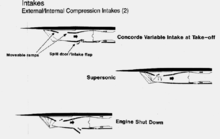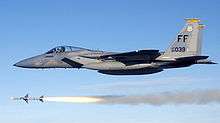Intake ramp

An intake ramp is a rectangular, plate-like device within the air intake of a jet engine, designed to generate a number of shock waves to aid the inlet compression process at supersonic speeds. The ramp sits at an acute angle to deflect the intake air from the longitudinal direction. At supersonic flight speeds, the deflection of the air stream creates a number of oblique shock waves at each change of gradient along at the ramp. Air crossing each shock wave suddenly slows to a lower Mach number, thus increasing pressure.
Ideally, the first oblique shock wave should intercept the air intake lip, thus avoiding air spillage and pre-entry drag on the outer boundary of the deflected streamtube. For a fixed geometry intake at zero incidence, this condition can only be achieved at one particular flight Mach number, because the angle of the shock wave (to the longitudinal direction) becomes more acute with increasing aircraft speed.
More advanced supersonic intakes feature a ramp with a number of discrete changes of gradient in order to generate multiple oblique shock waves. In the case of Concorde, the first (converging) intake ramp is followed by a diverging ramp. After the air passes the end of the first ramp it has become subsonic such that the diverging ramp further contributes towards the reduction in airstream velocity and consequently its increase in pressure. This intake design thus ensures excellent pressure recovery and contributes to Concorde's improved fuel efficiency whilst cruising supersonically at up to Mach 2.2 (beyond which airframe heating effects limit any further increase in speed).
For a fixed geometry it is feasible to use curved intakes without any shocks before the final normal shock. Modern fighter jets (like the F-22 Raptor) have engines so powerful that top speed is not limited by them, thus spillage at the intake is acceptable and a lightweight fixed geometry chosen. The nacelle has a round outer lip to deflect spillage back into the longitudinal direction. The nacelle thus gets a very large cross section with more volume than needed for the engine and in the F-22 the nacelles are combined with the fuselage to create a large weapon bay, place for fuel, and a wide body, which generates some lift. Modern jets have a horizontal ramp thus spillage at least produces some lift. In the case of the F-22 the inlet has two ramps placed in a diamond shape, thus for most Mach- and thrust-conditions spillage occurs only at the aft / lower corner of that diamond. In the case of the F-22 the leading edges of the wing become supersonic at Mach 1.8 and certainly are as large a source of wave drag as the inlet.
Variable geometry intakes, such as those on Concorde, vary the ramp angle to focus the series of oblique shock waves onto the intake lip, control of which is accomplished by complex non-linear control laws using the ramp void pressure (the pressure of the air in the gap between the two ramps) as a control input.
Intake gallery
-

Concorde ramp moves down on higher Mach numbers
-

The ramp of Concorde is clearly visible
-

F-14 with internal ramp
-

At subsonic speeds the ramp of the F-15 points downwards
-

Vertical ramp on the XB-70